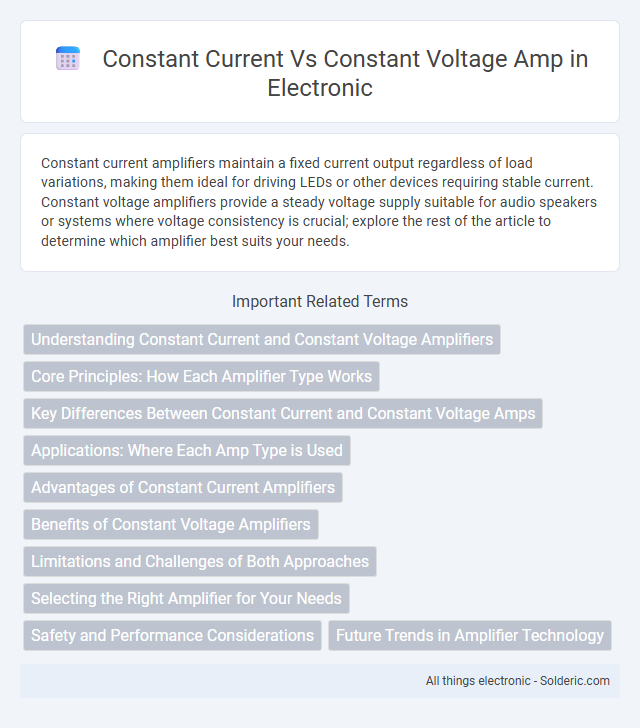Constant current amplifiers maintain a fixed current output regardless of load variations, making them ideal for driving LEDs or other devices requiring stable current. Constant voltage amplifiers provide a steady voltage supply suitable for audio speakers or systems where voltage consistency is crucial; explore the rest of the article to determine which amplifier best suits your needs.
Comparison Table
| Feature | Constant Current Amplifier | Constant Voltage Amplifier |
|---|---|---|
| Output Control | Maintains fixed current regardless of load | Maintains fixed voltage regardless of load |
| Primary Use | LED driving, battery charging, electroplating | Audio amplification, power supply regulation |
| Load Sensitivity | Voltage varies with load resistance | Current varies with load resistance |
| Control Method | Feedback regulates output current | Feedback regulates output voltage |
| Applications | Devices needing steady current, e.g. LEDs | Devices needing steady voltage, e.g. speakers |
| Typical Output | Current in Amperes (A) | Voltage in Volts (V) |
Understanding Constant Current and Constant Voltage Amplifiers
Constant Current amplifiers maintain a steady current output regardless of load changes, making them ideal for driving LEDs and laser diodes where precise current control is crucial. Constant Voltage amplifiers deliver a fixed voltage output, commonly used in audio applications and power supplies to ensure consistent voltage levels. Understanding the differences helps you select the right amplifier type to optimize performance and protect your electronic components.
Core Principles: How Each Amplifier Type Works
Constant current amplifiers regulate output current to remain steady regardless of voltage variations, optimizing performance in applications like LED driving and electrochemical processes. Constant voltage amplifiers maintain a fixed output voltage by adjusting current flow, ideal for audio systems and voltage-sensitive devices. Understanding these core operational differences is crucial for selecting the appropriate amplifier to match load requirements and ensure system stability.
Key Differences Between Constant Current and Constant Voltage Amps
Constant current amps regulate the current output to a fixed level regardless of voltage variations, making them ideal for applications requiring stable current such as LED drivers or battery charging. Constant voltage amps maintain a steady voltage output despite changes in load current, commonly used in powering electronic circuits and audio systems. Understanding these key differences helps you select the right amplifier type to ensure optimal performance and device protection.
Applications: Where Each Amp Type is Used
Constant current amps dominate LED lighting and battery charging applications because they deliver a steady current that prevents damage and ensures uniform brightness. Constant voltage amps are essential in audio systems and power supply units, where maintaining a stable voltage is critical for consistent performance. Your choice between these amps depends on whether your application requires fixed current or fixed voltage regulation.
Advantages of Constant Current Amplifiers
Constant current amplifiers maintain a stable current regardless of load variations, making them ideal for driving LEDs and resistive sensors with high precision. Their ability to protect sensitive components from current surges enhances the longevity and reliability of your electronic circuits. These amplifiers also improve performance stability in applications requiring consistent current delivery under fluctuating electrical conditions.
Benefits of Constant Voltage Amplifiers
Constant voltage amplifiers maintain a steady voltage output regardless of variations in load impedance, making them ideal for driving long speaker cable runs or multiple loudspeakers in parallel. They provide consistent audio quality and reduce signal degradation over distance, ensuring reliable performance in distributed audio systems. These benefits are crucial in public address systems and commercial installations where uniform sound distribution is essential.
Limitations and Challenges of Both Approaches
Constant current amplifiers face limitations such as increased heat dissipation and difficulty maintaining output stability under varying load conditions, which can affect overall system efficiency. Constant voltage amplifiers encounter challenges including voltage drops over long cables and potential distortion when load impedance fluctuates, impacting audio quality. Understanding these constraints helps you select the optimal amplifier type for applications requiring precise power management and signal integrity.
Selecting the Right Amplifier for Your Needs
Selecting the right amplifier depends on the requirements of your audio system and speaker type. Constant current amplifiers are ideal for driving speakers with variable impedance and avoiding distortion, while constant voltage amplifiers excel in delivering stable power to distributed speaker systems over long cable runs. Your choice should consider load characteristics and system design to ensure optimal sound performance and equipment longevity.
Safety and Performance Considerations
Constant current amplifiers deliver a steady current regardless of load variations, ensuring safety by preventing overheating and protecting sensitive components from current surges. Constant voltage amplifiers maintain a fixed voltage output, optimizing performance in applications like audio systems and LED drivers by providing stable voltage levels for consistent operation. Understanding these differences helps you select the appropriate amplifier type, balancing safety and performance based on your specific electronic system requirements.
Future Trends in Amplifier Technology
Future trends in amplifier technology emphasize enhanced energy efficiency and intelligent adaptive control, seamlessly switching between constant current and constant voltage modes to optimize audio performance. Integration of advanced digital signal processing (DSP) enables precise real-time adjustments tailored to speaker impedance and listening environment, improving sound clarity and reducing distortion. Your audio setup can benefit from emerging solid-state materials and AI-driven calibration systems, which promise increased reliability and personalized audio experiences.
Constant current vs Constant voltage amp Infographic

 solderic.com
solderic.com